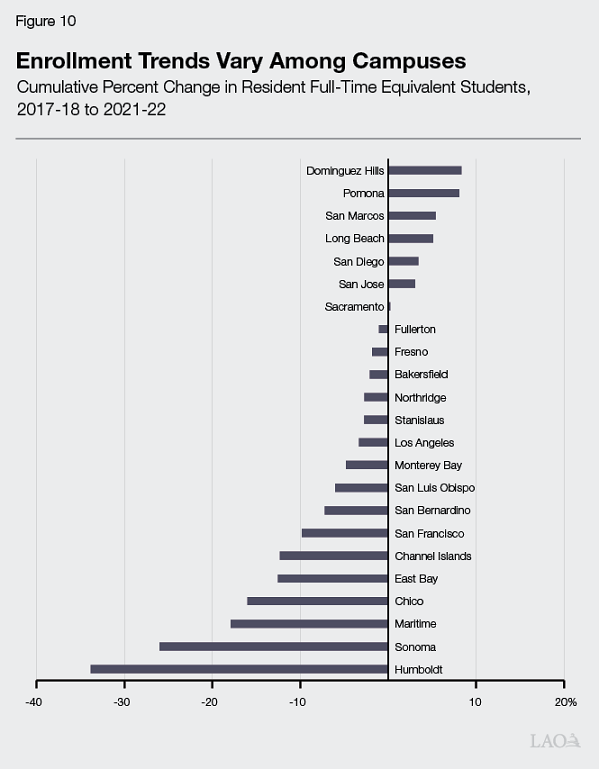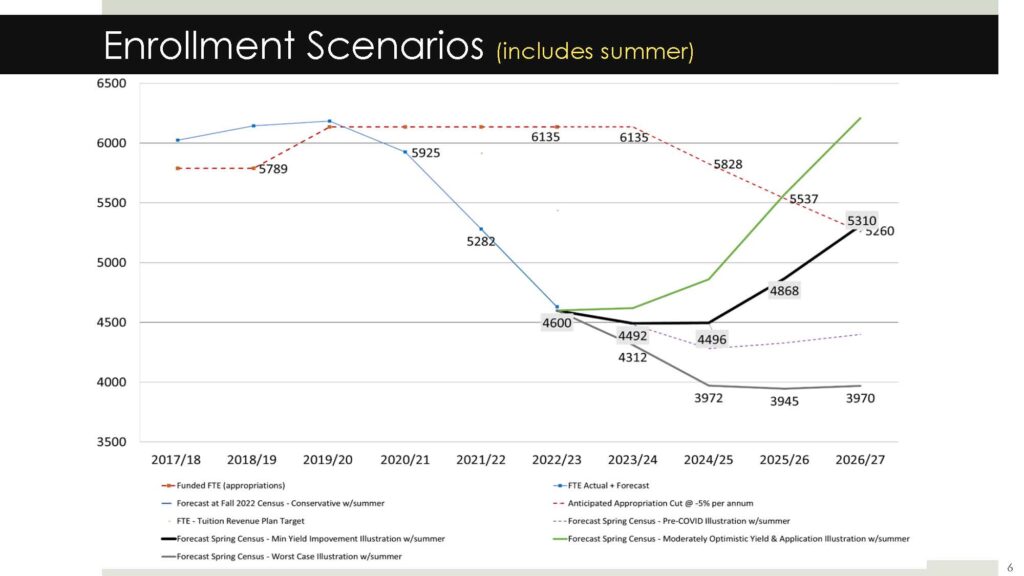Graphic by Elise Bechtel
By Sergio Mercado
This is part one in a series about CI’s current enrollment. Please return for future updates.
CI is currently facing an enrollment crisis. Of a funded 6,135 full-time equivalent (FTE) students, CI currently has 4,600 FTE students enrolled, marking a 25% deficit. Now, the CSU is placing an ultimatum: increase enrollment numbers or face budget cuts.

The Chancellor’s Office announced through “The CSU Enrollment Target and Budget Reallocation Plan” released on Jan. 11 that in academic years 2024-2025, 2025-2026 and 2026-2027, CSU campuses that were underperforming in enrollment would have smaller target funded FTE and smaller appropriations from the CSU budget, meaning less operating budget for each affected campus.
FTE students is a metric used to measure enrollment. It is calculated by taking the total amount of units that students are enrolled at a campus and dividing it by either 15 units per student for undergraduates or 12 units for graduate students, to represent full-time equivalent students.
For example, if a university has a total of 300 units enrolled, it would have 20 FTE students, while the actual headcount of students may vary. Therefore, FTE values can be affected if there is a change in the average amount of units that students enroll in per semester. On average, students at CI are enrolling in less units per semester than in 2019, which is contributing to lower FTE numbers.
Each year, universities in the CSU system receive general funds, or appropriations, granted from funds from the state budget based on a target number of FTE students determined by the CSU. Target enrollment numbers for each campus are allocated by the CSU based on enrollment trends and with the goal of reaching an overall CSU enrollment target. This number is given by the state of California, and the CSU distributes a general fund based on target enrollments for each campus.
According to an attached document in “Enrollment Challenges and Budget Updates,” a campus global sent to staff and faculty by President Richard Yao on Jan. 23, “The general fund is our primary source of funding, with our campus appropriation constituting roughly 80% of our general fund revenue.” CI has received general funds from the CSU to support 6,135 FTE students since college year 2019-2020 and was on track to reach this number of FTE students until enrollment started to decline in 2020-2021.
2024-2025 will be the first year the changes outlined by Chancellor Koester will take place, with schools 10% below funded enrollment targets getting a 5% cut in funded FTEs to be redistributed to schools at or above enrollment targets. With this comes the reallocation of $7,900 to $8,900 per FTE from underperforming campuses to other CSU campuses. CI is one of seven schools currently below this 10% threshold and is likely to face cuts to its general fund. As of right now, CI is 25% below its funded FTE enrollment, and it expects to face a $2.7 million reduction in general funds in fiscal year 2024-2025.

Five percent cuts to funded FTEs would continue into 2025-2026 and 2026-2027 for campuses that continue to get enrollment numbers below a certain threshold of the enrollment targets set by the CSU. For 2025-2026, that would be schools more than 7% below target and for 2026-2027, that would be schools more than 5% below enrollment targets.
These changes are expected to be permanent cuts to CI’s appropriations. If CI’s enrollment stays below the target enrollment thresholds, it could stand to lose around $7.8 million in annual appropriation by 2026-2027. According to the “Enrollment Challenges and Budget Updates” document, CI projections indicate that current enrollment trends could mean a “$2.7M decrease in permanent funding for 2024-25, $2.5M in 2025-26 and $2.4M in 2026-27.”
This disparity between target enrollment and actual enrollment is due in part to a nationwide trend as many college-aged adults seek other paths and enrollment in four-year colleges drops. The pandemic markedly caused a decrease in college enrollment, as factors such as concerns over the price of college, quality of education and other responsibilities pushed for lower college enrollment.
In fall 2021 alone, enrollment in four-year universities across the US dropped by 3.1% from the previous year, according to the National Clearinghouse Student Research. While this decrease in enrollment has been slowing down, total enrollment has continued on a downward trend. Student retention is also a large piece of this enrollment puzzle, as Cal Matters estimates 24,000 enrolled students left the Cal State system between fall 2020 and fall 2022.
Current plans to navigate the drop in enrollment and to help CI return to its target enrollment levels focus on increasing retention, as well as application and recruitment. “Retaining existing students is job #1,” President Yao said in the “Enrollment Challenges and Budget Updates.”
CI also plans to move summer session enrollment from Extended University to stateside management starting this summer. Courses under Extended University do not count towards state enrollment.
During the March 3 Strategic Resource Planning Committee meeting, President Yao shared three potential scenarios based on projected enrollment numbers in upcoming years. Projections used for planning are hopeful that CI will reach its funded FTE target in 2026-2027.

While cuts to CI’s general fund are not expected to take place until 2024-2025, CI’s administration is taking to manage future shortfalls in budget. For example, administration instituted a “hiring chill” on Jan. 18, in which waiver requests must be made and approved before vacancies are filled. Further discussion on cost-saving strategies will be held in Strategic Resource Planning Committee meetings.
As CI celebrates its 20th anniversary, it is tasked with confronting its decreasing enrollment. While the effects of the reallocation of funded FTEs may not be felt until 2024-2025, the way the University adapts and responds will likely shape much of CI’s third decade.
This is part one in a series about CI’s current enrollment. Please return for future updates.

